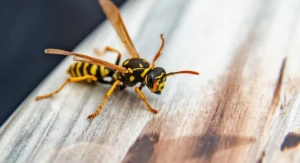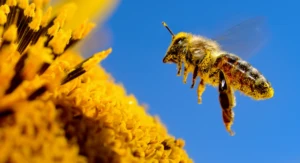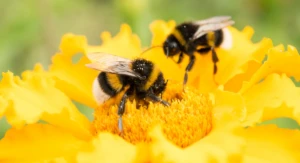Identifying Stinging Insects In Wisconsin
Wisconsin is home to various stinging insects that can become pests, especially during warmer months. These insects often build nests around homes, trees, and other outdoor areas, leading to potential health risks from their stings. Knowing how to identify these stinging insects and their dangers is crucial for homeowners. This guide will help you recognize common stinging insects in Wisconsin, minimize their presence, and understand when professional help might be necessary.
COMMON STINGING INSECTS IN WISCONSIN
Flying bugs that sting can be a real nuisance, especially during outdoor activities. Several species, like European hornets, carpenter bees, and mud daubers, are common culprits in North America. These flying insects that sting are equipped with painful stingers used for defense. Social insects, such as wasps and bees, are particularly aggressive, often stinging when their nests are disturbed. Knowing which insects sting is important to avoid encounters with these flying bugs. Understanding the behavior of stinging insects can help prevent painful encounters and manage their presence around your home.
WASPS
Wasps are social insects living in colonies known for their slender bodies and smooth stingers. One of the most common types, paper wasps, often build nests in sheltered areas like under eaves and soffits. Their nests, made of a paper-like material, resemble an open umbrella. Wasps can sting multiple times, and while they are generally non-aggressive, they can become highly defensive when protecting their nests.
HORNETS
Hornets are a type of wasp but tend to be larger, 5/8 to 7/8 inches long, and more aggressive. In Wisconsin, the bald-faced hornet is common and easily identified by its striking black-and-white markings. These hornets often build large, football-shaped nests in trees, shrubs, or on the sides of buildings. Due to their aggressive nature, hornets can pose a serious threat if their nests are disturbed.
HONEY BEES
Honey bees play a crucial role as pollinators, but they can become pests when their nests are located too close to human activity. Typically non-aggressive, honey bees will sting only if they feel threatened. They are about 1/2 an inch to 5/8 of an inch long, banded with orange, brown, or black, and mostly covered with pale hairs, especially on their thorax. They possess a barbed stinger, which is lost in the victim when the victim is stung. Honey bee nests are often found in hollow trees, attics, or wall voids, making them a potential nuisance in residential areas.
BUMBLEBEES 
Bumblebees are large, measuring from 1/2 to 1 inch long. They are full-bodied, fuzzy insects often mistaken for carpenter bees. Unlike honey bees, bumblebees can sting multiple times. They are social insects that live in colonies, typically nesting in the ground or abandoned rodent burrows. Their round, fuzzy bodies with yellow and black coloring make them easy to recognize, but their nests in shaded areas can still pose a risk to humans.
Carpenter Bees 
Carpenter Bees are named after their ability to drill into wood, where they carve out chambers and nurture their offspring. They’re also one of the largest native bees in the United States, similar to queen bumblebees. These bees are commonly found throughout the United States, including within Wisconsin. Even though they don’t eat wood, they often weaken structures by tunneling through dry or damaged lumber.
 
HEALTH RISKS OF STINGING INSECTS
Stings from insects like wasps, hornets, and bees can range from mildly painful to life-threatening, depending on individual reactions and the number of stings. While some people may experience temporary discomfort, others can face more serious consequences. Understanding these health risks is crucial to staying safe, especially when dealing with aggressive, stinging insects. Being vigilant and knowing what to expect can help protect your family and home.
ALLERGIC REACTIONS TO STINGS
For some individuals, stings from honey bees, wasps, or hornets can trigger severe allergic reactions, known as anaphylaxis. Symptoms may include difficulty breathing, swelling of the face or throat, a rapid heartbeat, dizziness, and, in extreme cases, anaphylactic shock. This type of reaction requires immediate medical attention and can be life-threatening if left untreated.
Common signs of an allergic reaction include hives, widespread itching, and swelling, especially around the face or throat. Breathing difficulties or wheezing may also occur. If you or a family member is allergic to insect stings, it’s important to have an epinephrine auto-injector and seek professional pest control if nests are found near your property.
MULTIPLE STINGS AND THEIR DANGERS
Stings from multiple insects, such as hornets or yellow jackets, can be dangerous even if you don’t have allergies. When these insects feel their nest is threatened, they may swarm and sting repeatedly. Multiple stings can result in extreme pain, swelling, and nausea. In some cases, an excessive number of stings can lead to venom overload, which can be life-threatening.
The intense pain, swelling, and potential for infection from numerous stings make these situations hazardous. If you encounter a nest, it’s safer to avoid disturbing it. Our professional residential pest control service is equipped to handle large colonies and remove nests without risking further injury.
HOW TO MINIMIZE STINGING INSECTS AROUND YOUR HOME
Reducing stinging insects around your home requires proactive steps to deter them. Whether using natural remedies or chemical deterrents, these methods can minimize the risk of infestations. Routine inspections and maintenance are essential to prevent insects from nesting around your property.
NEST REMOVAL TIPS
Removing nests is essential for controlling stinging insects but can be dangerous. Wasps and hornets often become aggressive when their nests are disturbed, increasing the risk of stings. While it may seem simple, attempting to remove nests—especially large or hard-to-reach ones—can lead to swarming.
Contacting a pest control professional in Wisconsin is the best way to get rid of stinging insects. Pest control professionals have the tools and knowledge to remove these pests from your property safely and without harm to you or your family. Our Home Protection Plan can help you keep stinging insects away from your home or business in Wisconsin.
Terminix Wil-Kil uses various methods to treat stinging insects, depending on the species and the location of the infestation. Here’s a general overview of our approach:
Inspection and Identification: The first step is to inspect the area and accurately identify the type of stinging insect. This is crucial because different insects, such as wasps, hornets, bees, or Mud Daubers, require different treatment strategies.
Nest Removal or Treatment: We will locate the nest for social insects like wasps and hornets and decide whether to remove it or treat it in place. Options include insecticidal sprays or dusts specifically designed to eliminate stinging insects.
Exclusion and Prevention: After dealing with the immediate threat, the focus turns to preventing future infestations. This can include sealing entry points, removing attractants (like food or trash), and advising on habitat modification.
Above all, we aim to ensure that your stinging insect problems are managed safely and effectively, minimizing the risk to your family and pets.
USING NATURAL AND CHEMICAL DETERRENTS
Deterring stinging insects from your property can be achieved through natural and chemical methods. Natural deterrents include planting insect-repelling plants such as mint, citronella, and eucalyptus around outdoor spaces. These plants not only keep stinging insects at bay but also enhance your garden’s aesthetic. Keeping garbage cans tightly sealed and removing standing water, which attracts insects like wasps and bees, are also effective preventive measures.
If natural options aren’t enough, chemical deterrents can be used, like insecticide sprays designed for wasps, hornets, and bees. These sprays can be applied around common nesting sites, such as eaves and attics, to deter new colonies from forming.
NEED HELP WITH STINGING INSECT CONTROL IN YOUR WISCONSIN HOME?
If stinging insects have become a nuisance in or around your home, it’s best to seek help from our professional residential pest control service. Handling aggressive species like hornets, wasps, or bees can be dangerous without the right equipment and expertise.
Why choose professional residential pest control? We offer safe and effective nest removal, long-term solutions to prevent infestations, and free quotes for Wisconsin homeowners. Don’t let stinging insects take over your outdoor spaces—contact us today for a Free Quote and enjoy peace of mind with professional residential pest control. Stay safe and enjoy the outdoors without the constant worry of stings!
Identifying Stinging Insects In Wisconsin in Sun Prairie, WI
Terminix Wil-Kil Pest Control is a local Pest Control and Extermination company helping homeowners and businesses with pest issues across WI.
